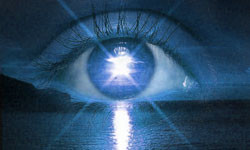Let me show you something. I haven’t drawn this out like this before, so let’s see how it goes. Take this in baby steps:
- Close your eyes. Think of the smallest point you can imagine, like the head of a pin from across the room. Don’t visualize a pin. Just consider the size of it, so that you know that a “point” is the smallest speck of detail that’s possible for the eye to perceive, for use in the next step.
- Open your eyes, and with the first thing you notice – and I mean in the first instant upon opening your eyes – pick a tiny point, then as soon as you picked it, let it go, and close your eyes. This is all done in an instant, as quickly as you can blink, without thought, without trying to locate a point to look at. It feels like you’re not doing anything, right? The only thing you’re really doing when opening your eyes for an instant is thinking of the size of a point, and that point is naturally placed in what you see for an instant as you open your eyes. You don’t have to see anything. You’re just picking a point that happens to be in a mess of blur, and you’re ignoring the fact that there is blur.
- Close your eyes, and remind yourself to look at a point again upon opening them.
- Repeat steps 2-3 several times.
- Try opening your eyes for long enough that you have time to let the first point go and pick a second point. You’ll find that it’s quickest to have the second point be close to the first.
- Close your eyes, and remind yourself to look at a point again upon opening them.
- Repeat steps 5-6 several times.
- Increase the number of points you hop between. open your eyes and hop among three points in succession, not paying attention to how well you see, and close your eyes again before you have a chance to worry about the blur.
- How long are you closing your eyes each time? Once you don’t have to remind yourself to look at a point upon opening them, shorten the time you close them.
- Start closing your eyes only for an instant. That’s called a blink.
- Start paying attention to what’s out there, and try placing the points in the area of something that you would like to see. Remember to let the points go as soon as you think of each one. Don’t struggle to try to accurately place the point on a specific spot, such as if you’re confused by double images or whatever. You’re placing the points independently of the actual image, and it never takes longer than an instant to place any point and let it go.
Believe it or not, this is how you’re actually supposed to see normally! That’s how effortless it is. You’re not doing anything. You have re-created your process of seeing from the ground up. Every time you find yourself forgetting to do this, take a moment and start over.
Isn’t it a relief to only be responsible for one point at a time? Heck, you don’t even have to see it. You just have to look at that point in space. So really you can’t fail. Your visual system eventually picks up all the slack, and that’s what it’s meant to do. It isn’t your job to perceive an image, or make sense of it, or focus on it. It’s your visual system’s job to do all that and spoon-feed it to you.
get help on our Facebook Group!

I founded iblindness.org in 2002 as I began reading books on the Bates Method and became interested in vision improvement. I believe that everyone who is motivated can identify the roots of their vision problems and apply behavioral changes to solve them.

Great activity, this is very feels very helpful and relaxing (and right!)
I was thinking, when I close my eyes and think of a point I tend to think of a point very close up front, it’s more natural for me than thinking of one across the room or far away – myopic tendency? Should I be thinking of a point far away? Should I be thinking of a point at about the distance of the chart or object I’m looking at when opening my eyes? Should the chart be at a very blurry distance or just a bit?
Thinking of a point close up is fine. And the chart should be at a distance where it’s a little blurry, so that your visual system has something to do.
Easy! Shitfting and central-fixation without trying! Nice way to relax.
Dave, thanks — this is great, so clear and so simple. Your last point, “Start paying attention to what’s out there…” is one I’ve been focusing on lately. I can see so much better when I pay attention to what I’m looking at! Keep the wisdom coming.
Nancy
Excellent explanation! I just wrote a post about memory, and how important it is to start by remembering small points. Then I came over here and discovered that you are writing on similar lines. I’ll add a link to this page. Cheers, Sorrisi